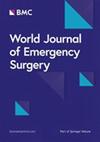Completely thoracoscopic surgical stabilization of rib fractures: balancing minimally invasive benefits against technique-specific complications: a single-center retrospective study
IF 5.8
1区 医学
Q1 EMERGENCY MEDICINE
引用次数: 0
Abstract
This study aimed to investigate the surgical outcomes and complications of completely thoracoscopic surgical stabilization of rib fractures (cTSSRF) in patients with rib fractures in the posterior chest wall area. A retrospective analysis was conducted on 30 patients who underwent completely thoracoscopic surgical stabilization of rib fractures (cTSSRF) between September 2019 and October 2023. Clinical data were gathered to compare and analyze the clinical outcomes of complications of cTSSRF and open surgical stabilization of rib fractures (oSSRF). A total of 201 rib fractures were repaired in 30 patients, including 79 rib fractures in the posterior chest wall (an average of 2.63 rib fractures/person) that were fixed by cTSSRF, and 122 rib fractures (an average of 4.06 rib fractures/person) fixed by oSSRF. No obvious thoracic collapse deformity was observed postoperatively in any patient. The median duration of chest tube removal after surgery was 3 (3–4) days, and the chest drainage volume was 586.33 ± 232.4 ml. The numeric rating scale score (NRS) was 3 (2–3.25), which was significantly lower than the preoperative score of 7 (6–8), z = -4.826, P < 0.001). The rate of implant displacement of the cTSSRF was 6.33% (5/79), which was significantly higher than that in the oSSRF of 0(0/122), χ2 = 5.53, P = 0.019. The rates of fracture malalignment were high in the cTSSRF (21.52% [20/79] vs2.46% [3/122], P < 0.001). The incidence of postoperative encapsulated pleural effusion—defined as a maximum anteroposterior fluid thickness > 20 mm surrounding the internal fixation device on axial CT scans—was 46.7% (14/30 cases) during the 7–14 day postoperative period. All patients were followed-up in outpatient clinics or by telephone for 6–24 months, and all resumed their work capacity without obvious symptoms of chest discomfort. The application of cTSSRF is a safe, feasible and minimally invasive surgical option, particularly in cases of rib fractures in the posterior chest wall, which are challenging to address using conventional open surgery. However, the postoperative implant displacement and fracture malalignment rates are higher than those observed in conventional surgery, which still needs to require careful evaluation of the risks and benefits of routinely performing cTSSRF.完全胸腔镜下肋骨骨折手术稳定:平衡微创益处与技术特异性并发症:一项单中心回顾性研究
本研究旨在探讨全胸腔镜下肋骨骨折手术稳定(cTSSRF)治疗后胸壁肋骨骨折患者的手术效果和并发症。回顾性分析了2019年9月至2023年10月期间接受全胸腔镜下肋骨骨折手术稳定(cTSSRF)治疗的30例患者。收集临床资料,比较分析cTSSRF和开放手术稳定肋骨骨折(oSSRF)并发症的临床结果。30例患者共修复201处肋骨骨折,其中cTSSRF固定后胸壁肋骨骨折79处(平均2.63处/人),oSSRF固定肋骨骨折122处(平均4.06处/人)。术后未见明显胸塌陷畸形。术后拔胸管时间中位数为3(3 -4)天,胸腔引流量为586.33±232.4 ml。数值评定量表评分(NRS)为3(2-3.25),明显低于术前评分7 (6-8),z = -4.826,轴位CT扫描内固定装置周围P 20 mm -术后7 - 14天为46.7%(14/30例)。所有患者均在门诊或电话随访6-24个月,均恢复工作能力,无明显胸部不适症状。cTSSRF的应用是一种安全、可行和微创的手术选择,特别是对于后胸壁肋骨骨折的情况,这是传统开放手术难以解决的问题。然而,术后植入物移位和骨折不对齐率高于常规手术,因此仍需仔细评估常规cTSSRF的风险和收益。
本文章由计算机程序翻译,如有差异,请以英文原文为准。
求助全文
约1分钟内获得全文
求助全文
来源期刊

World Journal of Emergency Surgery
EMERGENCY MEDICINE-SURGERY
CiteScore
14.50
自引率
5.00%
发文量
60
审稿时长
10 weeks
期刊介绍:
The World Journal of Emergency Surgery is an open access, peer-reviewed journal covering all facets of clinical and basic research in traumatic and non-traumatic emergency surgery and related fields. Topics include emergency surgery, acute care surgery, trauma surgery, intensive care, trauma management, and resuscitation, among others.
 求助内容:
求助内容: 应助结果提醒方式:
应助结果提醒方式:


